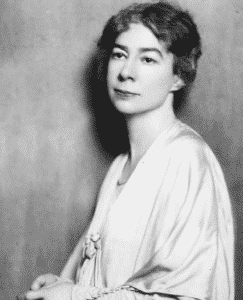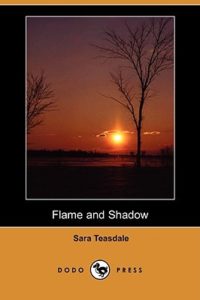She didn’t live here her entire life, but St. Louis claims poet Sara Teasdale (1884-1933) as one of its own.
The Teasdale family was well-to-do. Their first home was on Lindell Boulevard, in the area we call “midtown,” the intersection of Grand and Lindell boulevards. Today, the Grand Entertainment District is on the north side of Lindell and St Louis University is on the south. The Teasdale home was located on land now occupied by university buildings.
The family moved west to Kingsbury Place, a few blocks north of Forest Park. This area was being developed as an enclave of private streets before, during, and after the St. Louis World’s Fair. Teasdale’s house still stands; Kingsbury Place is still a beautiful street with large, well-maintained homes. (Not long ago, it was sold for $1.1 million.)

The Teasdale home at 38 Kingsbury Place, St. Louis
For a year, Teasdale attended Mary Institute, a girls’ school located at Locust Street and Jefferson Avenue. The principal was T.S. Eliot’s father; Eliot, four years younger than Teasdale, was known for antics and pranks to get the attention of the girls in the school. It’s intriguing to think of Sara Teasdale watching the young T.S. Eliot acting out. The school moved west, finally ending up in St. Louis County. Some years ago, it merged with St. Louis Country Day School for boys to become MICDS (Mary Institute and Saint Louis Country Day School), considered the most exclusive private school in St. Louis. After a year at Mary Institute, Teasdale transferred to Hosmer Hall School for Girls.
From 1904 to 1907, she was a member of a group called The Potters, young women who published an arts and literary magazine called The Potter’s Wheel. In 1907, her first poem was published by Reedy’s Mirror, a St. Louis newspaper. While living in St. Louis, she published her first three poetry collections, Sonnets to Duse (1907), Helen of Troy (1911), and Rivers to the Sea (1915), which became a national bestseller. Among her many suitors was the poet Vachel Lindsay, but she married Ernst Filsinger in 1914. Two years later, the Filsingers moved to New York City.

Sara Teasdale
For 32 years, Teasdale was a St. Louis girl, living a life of privilege in the city’s Central West End. It was a time when St. Louis was at the height of its wealth and importance, when young women of well-to-do families were expected to marry well and raise families. Teasdale almost fit that mold; she married well but had no children. Her life was poetry.
Teasdale’s collection Flame and Shadow (1920) provided the prompts for the recent “Twitter party without Twitter” at the Tweetspeak Poetry retreat at the Center at Mariandale in Ossining, New York. The participants may not have known all the details of Teasdale’s life in St. Louis, but they were carrying on the tradition and inspiration of The Potters. I think Teasdale might have smiled.
The first five poems were published last week; here are the final five.
Flame and Shadow
By Michelle Ortega, Rhonda Owen, Tania Runyan, Megan Willome, Sandra Heska King, Callie Feyen, Laura Brown, Sonia Joie, Sara Barkat, L.L. Barkat, and Will Willingham; edited by Glynn Young. Prompts courtesy of Sara Teasdale (Flame and Shadow, 1920).
Vacant fields
The detritus of a poetry weekend
comes back to me, here in vacant fields,
a Midwest skyline rising round
the south bend of a lake.
I forgot the name, my favorite canyon,
a mile of miracles, the scent of its soil
and the hips and shoulders of its hills,
inclines, really, less than hills,
sleeping in cobalt sleet,
sinking in cobalt flames.
You’re welcome to come back.
Every morning, not Paris,
in the wail of leaving,
a lonely turkey flies toward the moon.
Sleepless, longing for home,
land of alligators and pythons,
I want to ride my bicycle past an alligator,
humidity pods darkening the dawn.
Come back to me.
“Heaven is lighting star after star”
I didn’t say I had a hard time reading;
I said I had a hard time darkening stars,
dancing barefoot, healing trauma.
To catch a falling star, star after star
in the hush, in the wind, in the earth
is blow them out, making a wish for each,
while bees sleep in lightning stars
and poets name constellations.
The end of love
“Born on the hush of the wind,”
died in the howl of the storm,
love has left the station.
Love has left this memory, let it dream
finis, finis, finish. Its memory,
released, howls its first and last cry.
I pine for your loveliness;
I have loneliness to quell.
The cliff glistens in the rain.
The time to pet bees has arrived;
I will find these dreams, sweet
like honey, and save them like a hive.
I got hives from kissing you
in the warmth of the wind.
I wrap a snake around my wrist
to remember I’m alive.
Setting a table
Setting a table for white jasmine tea
and coffee, holding possibility like a spoon,
cupping joy, cupping hope, drowning
in the cup or swimming beside it.
The coffee quivers with the wind,
a golden measure in the wind,
with silver cups and silver pines
and lines of silver, soft as song.
Close this finished book, lay it in the fridge
With the blueberries in the dusty fridge.
Is there a reason you left your soup outside?
Were you ready for a surprise?
Let me throw chickpeas at your feet
Related:
A Live Tweetspeak Poetry Party (With Sara Teasdale), Part 1
Photo by Michael Leckman, Creative Commons, via Flickr. Post by Glynn Young.
__________________________

“I require all our incoming poetry students—in the MFA I direct—to buy and read this book.”
—Jeanetta Calhoun Mish
- “Your Accent! You Can’t Be from New Orleans!” - October 9, 2025
- Poets and Poems: Donna Vorreyer and “Unrivered” - October 7, 2025
- Poet Sidney Lanier and the Lost Cause - October 2, 2025


Leave a Reply